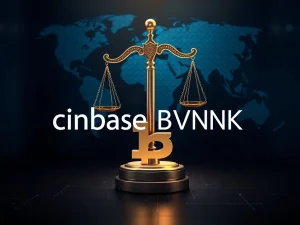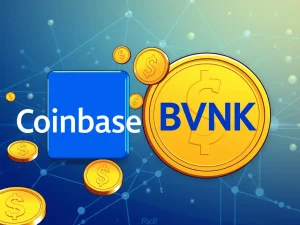Revolutionary Coreum Blockchain: Blazing 7,000 TPS Trail for Regulated Finance Future

In the fast-evolving world of cryptocurrency and blockchain, speed, security, and compliance are paramount – especially when it comes to regulated finance. Enter Coreum, a third-generation blockchain making waves with its astonishing transaction processing speed of 7,000 TPS (transactions per second). But is speed everything? Let’s dive deep into how Coreum blockchain is not just about velocity, but about strategically positioning itself as the backbone for the future of regulated financial applications.
What Makes Coreum Blockchain a Game Changer for Regulated Finance?
Forget the sluggish transaction times of yesteryear. Coreum blockchain is engineered from the ground up to meet the rigorous demands of institutional finance. Imagine a blockchain framework that not only boasts lightning-fast 7,000 TPS but also integrates compliance directly into its core architecture. This isn’t just about faster transactions; it’s about building a secure and compliant ecosystem where regulated assets can thrive. A recent report by Crypto News Insights Research sheds light on Coreum’s innovative approach, examining its:
- Technical Architecture: Designed for high throughput and reliability.
- Compliance Framework: Built-in features for KYC and AML.
- Impact on Tokenization: Facilitating the secure tokenization of real-world assets (RWAs).
This report underscores how Coreum blockchain is tackling the critical challenges hindering wider institutional adoption of blockchain technology.
The Need for Speed: Achieving a Blazing 7,000 TPS
In the world of finance, speed is indeed critical. Traditional blockchains often struggle with scalability, leading to bottlenecks and higher transaction costs. Coreum blockchain addresses this head-on. But how does it achieve such impressive speeds? Network data reveals:
- Transaction Throughput: Over 7,000 TPS, significantly outpacing many layer-1 competitors.
- Time to Finality: Approximately 1.2 seconds, ensuring rapid transaction confirmation.
This level of performance is not just about bragging rights. It’s about creating a blockchain environment capable of handling the high-volume demands of institutional trading and financial applications. This speed translates directly into:
- Reduced Transaction Costs: Deterministic fees ensure predictable and efficient cost structures.
- Enhanced User Experience: Faster confirmations lead to smoother and more responsive applications.
- Scalability for Growth: Ready to handle increasing transaction volumes as adoption grows.
Compliance First: A Cornerstone of Coreum’s Design for Regulated Finance
For financial institutions, regulatory compliance isn’t an afterthought; it’s a prerequisite. Coreum blockchain understands this imperative and integrates compliance features directly at the protocol level. This is a significant departure from many conventional blockchains where compliance is often bolted on as a third-party application. Coreum’s approach includes:
- On-Chain KYC and AML: Integrated directly into the network in collaboration with AnChain.ai, a leading AI-driven compliance provider.
- Real-Time Risk Assessment: Proactive fraud detection and risk management built into the protocol.
By embedding compliance at its foundation, Coreum blockchain offers institutions a secure and transparent environment, fostering trust and facilitating easier navigation of complex regulatory landscapes. This proactive approach to compliance is a key differentiator for institutional adoption.
Why Institutional Adoption is Poised to Accelerate with Coreum
The institutional embrace of blockchain is no longer a question of ‘if’ but ‘when’ and ‘how’. With the value locked in tokenized real-world assets (RWAs) surging by 85% in 2024, the momentum is undeniable. Coreum blockchain is strategically positioned to capitalize on this trend, offering a compelling proposition for institutional investors and financial firms due to its:
- Scalability: The 7,000 TPS capability ensures it can handle institutional transaction volumes.
- Regulatory Compliance: Built-in features simplify adherence to KYC and AML requirements.
- Interoperability: Seamless connections with other major blockchains like XRP Ledger and Cosmos/IBC.
- Deterministic Fees: Predictable transaction costs are crucial for financial planning and operations.
These factors collectively create a robust and institution-friendly ecosystem, paving the way for wider institutional adoption of blockchain technology.
Unpacking Coreum’s DEX: A Powerful Tool for Institutional Trading
Decentralized exchanges (DEXs) are revolutionizing trading, but traditional AMM-based DEXs can present challenges for institutional traders, such as slippage and impermanent loss. Coreum blockchain takes a different route with its built-in on-chain order book DEX. This architecture offers significant advantages for institutional trading strategies:
| Feature | Coreum Order Book DEX | AMM-Based DEX |
|---|---|---|
| Trade Execution | Deterministic, minimal slippage | Potential slippage, price inefficiencies |
| Liquidity | Order book driven | Liquidity pool dependent |
| Suitability for Institutional Trading | Highly suited for institutional strategies | Less ideal due to unpredictability |
Furthermore, Coreum’s DEX boasts:
- High-Frequency Trading Support: Transaction speeds comparable to traditional financial exchanges.
- Advanced API: Low-latency access for integration with institutional trading systems and automated strategies.
This advanced DEX infrastructure empowers financial firms to seamlessly integrate Coreum blockchain into their existing workflows, leveraging the benefits of blockchain-based settlement while maintaining compliance and efficiency.
Interoperability: Bridging Blockchain Ecosystems for Seamless Asset Movement
In a multi-chain world, interoperability is key. Coreum blockchain recognizes this and has strategically integrated with major blockchain ecosystems, including:
- XRP Ledger (XRPL): Leveraging XRPL’s efficiency in payments and settlement.
- Cosmos/IBC Network: Accessing a vast network of over 100 interconnected chains and its modular interoperability framework.
These integrations facilitate seamless cross-chain liquidity and asset transfers, creating a powerful environment for financial applications that require interaction across different blockchain ecosystems. This interoperability is crucial for institutions seeking to leverage the strengths of various blockchain networks without compromising security or compliance.
Conclusion: Coreum – Forging the Path for Regulated Finance on the Blockchain
Coreum blockchain emerges as a compelling case study in how third-generation blockchains are evolving to meet the stringent demands of regulated financial markets. Its focus on speed, compliance, and interoperability, combined with its innovative DEX infrastructure, positions it as a frontrunner in the race to bridge the gap between traditional finance and the world of crypto. As institutions increasingly explore blockchain solutions, Coreum’s robust framework and forward-thinking design make it a powerful contender to shape the future of regulated finance on the blockchain.
Disclaimer: This article is for informational purposes only and does not constitute investment advice. Cryptocurrency investments are inherently risky, and readers should conduct thorough research before making any decisions.
#Blockchain #Investments #KYC #AML #DeFi #Web3 #DEX #Regulation #Crypto News Insights Research Reports #RWA Tokenization Editor’s Choice Pi Network price nears all-time lows as supply pressure mounts Bitcoin sales at $109K all-time high ‘significantly below’ cycle tops — Glassnode Blockchain projects fight for 23andMe user data amid bankruptcy GUN token’s $69M milestone, Pudgy Penguins go to LOL Land: Web3 Gamer The future of digital self-governance: AI agents in crypto Advertise with us







